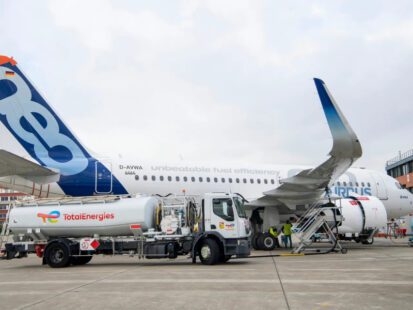
With the potential to supply gigawatts of offshore wind for electricity and hydrogen production and to interconnect countries across the region, the North Sea is key for the evolution to net zero.
“The North Sea needs to become the green energy production plant of Europe, the hotspot in the climate fight in Europe”, declared Yara Chakhtoura, newly-appointed managing director in France for Siemens Energy, opening a high-level panel discussion at Enlit Europe in Paris.
Pointing out how the company is engaged in multiple projects in the region, from the delivery of offshore wind turbines to HVDC cabling for interconnectors and a pioneering hydrogen project primarily to decarbonise shipping, she said that a joint approach between countries and players such as regulators and developers is needed.
“If we want to build an integrated decarbonated energy system, we’re going to have to rely on electrification, which means that decarbonated energy production is going to be a strong grid backbone to deliver green electricity throughout Europe.”
The North Sea’s energy sector has been built around the oil and gas industries, with infrastructure, supply chains and workforces in the various surrounding countries.
While these will continue to be important businesses in the years ahead, offshore wind is also becoming increasingly important. The latest targets set out in the Ostend Declaration of April 2023 are at least 120GW by 2030 and 300GW by 2050 from the governments of Belgium, Denmark, France, Germany, Ireland, Luxembourg, the Netherlands, Norway, and the UK.
Currently, the installed capacity of offshore wind in the North Sea is approximately 30GW, highlighting the considerable effort required to meet the targets.
But Pierre Tardieu, Chief Policy Officer at Wind Europe, warned of a disconnect “between the clear political direction and the many challenges that need to be addressed”.
Among these, he mentioned auction design, which he noted can be corrected with a ‘quick fix’, such as the increase in the ceiling price to more closely reflect the input costs that were implemented in the UK between auctions.
“That’s a good example of things that can happen going forward. Now we need to roll up our sleeves and get to work,” he said, pointing to the European Commission’s Wind Power Package as a guide.
Developer perspective
Anders Brendstrup, power-to-X Vice-President and Head of EPC at European Energy, highlighted the potential of power-to-x, referencing the development of a hydrogen plant in Esjberg and the hydrogen-methanol plant in southern Jutland in partnership with Siemens Energy to deliver e-methanol for shipping and the plastics industries.
Using hydrogen from Siemens Energy’s 50MW electrolyzer plant, it will provide fuel for shipping giant Maersk. The facility is ten times larger than anything to date.
But it’s an area that needs much more investment, he said, mentioning the need for a ‘grid’ for hydrogen. For example, much of the electricity from the North Sea will need to be exported in the form of hydrogen rather than via cables.
“Investment activity is starting to happen but there are little investment decisions, and we hope the politicians will commit.”
Brendstrup also noted the supply chain challenge for e-methanol, with around 220 methanol-enabled ships on order worldwide. It can be the starting point for CO2-neutral shipping on a large scale.
“A lot of things are happening by ours and other companies and it’s a start and we see big potential both in shipping as well as in the traditional methanol market.”
Read more:
How to embrace circularity in wind power
Siemens Energy’s Future Energy Perspectives Series
The TSOs talk
René Postulart, Associate Director of Large Offshore Projects at TenneT, said two big challenges face the company – the massive investment to scale up generation for electrification for large-scale decarbonisation, and the need for an integrated meshed grid to carry that generation.
He added that there is also a practical side to these projects. “We’re currently connecting 1GW per year to the grid, but by 2029 it will be 8GW. In terms of the connection capacities, we will have to multiply the outputs,” he said, highlighting the importance of standardisation and combining projects in ‘convoys‘.
As an example of the potential, he cited building several additional cable installation vessels for TenneT’s 2GW programme based on a portfolio of projects for the cable suppliers.
Gro Wæraas de Saint-Martine, Director Strategy & Development Offshore Grids at RTE, said the company’s approach to scaling up its offshore wind capacity – newly announced as 18GW by 2035 and 45GW by 2050 – was embodied in its ‘SMS’ strategy: Standardisation, Massification (effectively combining projects for tendering), and Simplification.
“Culturally TSOs and some of our suppliers like things to be perfect, but in the current world, that can’t be, and we are aiming at simplifying our contracts, specifications, permitting, processes – everything, to do it simply as much as we can,” she said, adding that contracts for up to €20 billion are coming up for signing in the next two years.
Political points
The western Jutland coastal city of Esbjerg has become well-known as a hub for the offshore wind industry, driven in no small part by its Mayor, Jesper Frost Rasmussen.
Up to the 1970s, the main business was fisheries, which then transitioned to oil and gas and subsequently offshore wind when the port served as a hub for the first such development – and the first in the world – in the late 1990s.
“Since then, we have been growing with the industry and there has been good cooperation between the municipality, the port, private businesses, the authorities – everybody working together,” he explained.
Commenting that more than half of the offshore turbines in the world – 29GW for more than 50 projects – have been deployed from Esbjerg, he said preparations are in place to deliver 4.5GW of turbines annually.
“That’s a huge potential and it is a huge task to fulfil the ambitions of the Esbjerg and Ostend declarations, but I think we will play a vital role. There is a need for more port and production capacity, and everybody needs to step up to achieve all these goals.”
Huge potential
The round table discussion reiterated the huge potential of the North Sea to contribute to the energy transition, with hybrid offshore wind farms set to play a key role.
Both the offshore and onshore grids need to be built up to deliver the output, with anticipatory investments key to their delivery and that of other infrastructures.
Industrial clusters are important for optimising the energy system and its delivery at regional and local levels.
Carbon capture and storage also is set to play an important role but it is in its early stages and needs to scale up before likely to see significant supply chain investments.
At the project level, the panellists agreed that standardised processes and collaboration are key for accelerating offshore wind development. Project visibility and the clustering of projects are also important to manage the supply chain.
However, several challenges need to be addressed. One is the timing of projects, with regulatory and permitting procedures that need to be streamlined. TenneT, for example, is advancing projects ahead of the granting of licences.
The skilled workforce shortage is also a major bottleneck, with a significant gap between the current workforce and the number of people needed to meet the offshore wind targets.
Various initiatives were highlighted, such as training programmes and attracting talent from other sectors.
Looking ahead, integration and coordination between countries are essential, with offshore wind projects and interconnectors often spanning multiple countries.
Finally, innovation and technology advancements are critical for further progress. “We’re on the right path,” said Chakhtoura.
“A strong and united Europe needs a resilient and sustainable energy system. The North Sea gives us that opportunity – it’s time to act together now.”
Watch our Connect Interview with Yara Chakhtoura:
New Managing Director of Siemens Energy France shares her vision for the energy transition




